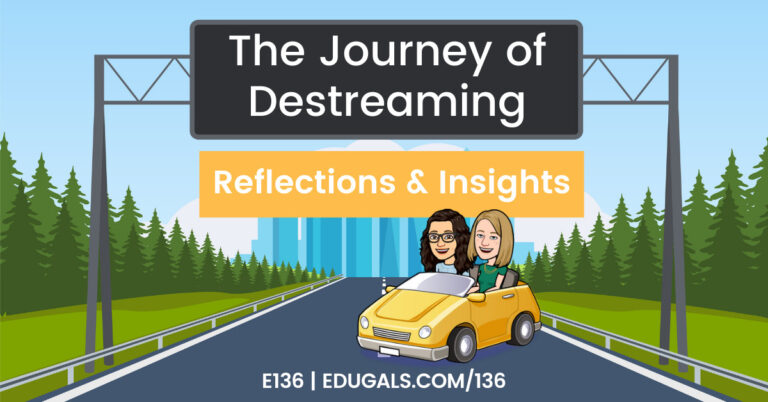In this episode, we chatting all about what has changed, and what really hasn’t in terms of schools and grading practices. We are returning to “Grading for Equity” by Joe Feldman, and discussing chapter 2 – the history of education, and movements that have impacted the system.
If you like what you hear, we would love it if you could share this episode with a colleague or friend. And make sure you subscribe so that you don’t miss out on any new content! And consider supporting the show by buying us a coffee or two!
We would love to hear from you – leave a comment on our website OR check out our FLIP!
Show Notes
This week, we are back with “Grading for Equity” by Joe Feldman. We are going to take a bit of a deeper dive in chapter 2, which is all about the history of grading.
If you haven’t yet, check out Episode 130, where we discuss Chapter 1!
It’s a shorter chapter, but we have to say that it’s a powerful chapter in how much it made us reflect on schools today, based on the reading of this history.
It’s interesting that many of the practices that we do within schools have changed over the years, yet grading really hasn’t. Also, learning skills, while we have added to them over the years, the ones that we seem to value the most haven’t changed.
It’s very fascinating, and eye opening. So instead of talking around it, we’re going to dive right in!
The rise of manufacturing
As society changed, and manufacturing became an area of growth and change, this created a need for changing how we teach and prepare people for the work world.
Our model of school, as it is today, was designed to produce kids as really good factory workers. School was like an assembly line of teaching kids the skills that they need in order to be successful in that sort of work environment.
This meant looking more at skills that they would need to be good employees, versus good thinkers or good learners.
These skills included ensuring students could listen to and understand the chain of command, routines, self-regulation, etc. which makes sense in a factory setting.
However, when we look at jobs today, these aren’t necessarily the highest sought after skills anymore. With the rise of AI, jobs that require those skills are the ones that are typically getting replaced.
So having a school system that is based on self-regulation, understanding authority, responsibility and routines, and doing things in a specific order – while these individual skills are important to be developed in a variety of ways, what we are teaching and valuing right now is only preparing students for jobs that will likely not even exist.
With the rise of AI, and with everything that has happened in the past 6 months or so of education, the focus needs to be more on thinking and critical thinking skills because AI can’t necessarily do that. What differentiates us from other living things on the planet is that humans are designed to think, and to be able to think critically, so why are we not preparing kids for that?
Migration and immigration
With the mass rush to North America from Europe, etc. in the past, this new wave of immigrants meant that we needed to look closely at education.
Governments wanted to make sure that everyone was being educated in the same way, and that everyone was getting ready for society as they wanted it to be. This meant the creation of what it meant to be American, or Canadian, and what that should look like.
There was also the migration from rural areas to more urban areas, and looking at the needs of the cities and places, and where people could fit. It was also where we wanted people to fit based on who they are, what they look like, and where they come from.
With this in mind, school settings were designed to basically assimilate students into society.
This made us think about the history of Indigenous Peoples in Canada (and North America), and the history of residential schools in particular. These schools were designed to make children fit a particular mold, and to act, speak, etc. in a particular way, leaving behind their own cultures, languages, identities, etc.
While school boards are starting to recognize and make changes to try to embrace the many cultures and languages, and differences that we have, it’s still a very colonial system, and we really haven’t changed that much from when the system began.
Intelligence testing and categorization
In this section, Feldman talks about the introduction of IQ testing and the categorization of people into a hierarchy of intelligence, based on a test that was not designed equitably.
IQ tests were used for a period of time for streaming purposes. We know now how biased these tests are, so using IQ tests to sort students into different schools seems totally wrong to us.
Pathways were then determined, and these tended to divide people across race, skin colour, languages, etc. where white, English speaking people were in the highest stream. These pathways were vocational versus more academic streams, which would determine future jobs or opportunities.
The one positive here is that, in Ontario, we are moving away from streaming through the creation of destreamed Grade 9 courses. This delays pathway decisions by at least a year, so that students can make more informed decisions about their futures.
That being said, we still have issues of streaming, and those who fit the norm, or understand how society wants us to act and think and speak, and those who fit that profile, tend to be the ones who get to maintain that higher level learning.
Research has shown, at least in Ontario, that those most likely to be affected by streaming practices are minority groups, and black students in particular. With this in mind, we really need to take a hard look at this school system that was created so long ago, and we need to look at the opportunities we are creating for all students, and completely overhaul these streaming practices.
John Dewey was discussed extensively in this chapter. It’s fascinating how progressive he was for his time, and how he was trying to take on this fight so many years ago. He already recognized those inequities that were present in practices, like streaming, grading practices, etc. He recognized and saw institutional problems in society as being more about income inequity rather than race – but nobody really wanted to listen to him.
Dewey also saw schools as a way to increase or move up in terms of social economic positioning and moral development. He saw education as a tool that people could use, and yet the system was quite clear that that was not what they wanted.
We need to continue to fight against inequities in the system, because as we can see, it take so long for changes to happen.
Destreaming, in some ways, is going to help with that, as it gives students more time to make decisions for their future. However, often the finish line keeps moving. We still have those who think that university is the one and only way to succeed, though there has been a lot of changes in the college system that has shown us that both college and university are equally great pathways – it really depends on the end goal, or the career/job you want.
To be honest, it often feels like university undergraduate programs only prepare you for the next program that is required to get you to a job or career. Whereas college programs are much more field specific, and they tend to lead to more careers, and tend to prepare you far more as a marketable employee.
Psychologists and/or behaviourists in education
Feldman also talks about other psychologists, and how they factor into how we educate and prepare students. For example, the chapter talks about behaviourists such as Pavlov and BF Skinner, discussing conditioning, and how it has been applied to the education system.
The education system was created to train or condition people to behave a certain way that society and work deems appropriate.
On page 21, Feldman shares a passage from an 1874 education document that states that schools should be teaching obedience and very specific skills. The passage states that:
“Great stress is laid upon (1) punctuality, (2) regularity, (3) attention, and (4) silence, as habits necessary through life for successful combination with one’s fellow-men in an industrial and commercial civilization.” (Harris & Doty as cited in Tyack, 1974, p.50
These four ‘habits’ that were seen as important in school classrooms are often still present in today’s classrooms, despite the fact that workplaces have changed, and society has changed as well.
We still remember our own experiences as students, and often if you were not quietly working in class, the teacher would get upset. Now, as an educator, I don’t want or value a silent classroom. I want students to be talking, thinking out loud, and feeling like it’s a safe space for them to speak.
That being said, we recognize that this perhaps hasn’t shifted for all teachers. There are still many classrooms where students are working quietly, and the teacher is the one at the front of the classroom delivering a lesson.
Silence does not indicate that students are on task and paying attention. Often in the noise of our classrooms, we can hear so many different conversations, and most are actually discussing the lessons or activities, working in groups, writing on boards together, etc. Are there some side conversations unrelated? Sure. That happens, but that doesn’t mean students are not on task.
Some of the behaviours that we look for in students are changing and shifting. But there are still some that haven’t.
Punctuality is still highly valued. We want students to get to class on time, and to complete work within agreed upon timeframes. However, we all know that life happens, and duedates aren’t always able to be met. So how are we preparing students for these conversations about extending due dates based on things that come up?
Grading in the twentieth century
In the last section of the chapter, Feldman talks about grading specifically, and what that looked like through the 20th century.
Grading began as very descriptive, through conversations with families, written sort of feedback in terms of where students are, where they’re going, and what they need to work on next. This type of grading was very individualized.
Once manufacturing started to expand, and schools expanded, this style of grading and feedback became less realistic due to the increase in students. This is when letter grades were introduced as a more efficient way to communicate grades.
While it may be more time effective, and we do so the need to change the process with the increasing number of students, we like to see that many educators are starting to return to more of an individualized, student-specific approach to feedback.
We still have to report on a grading scale because we were in a system that is based on rules and we are told how to report and the grading scale we need to use.
One of the other methods that Feldman talks about is the idea of grading on a curve, and grading with a bell curve. The idea behind this discussion is that it was believed that the distribution of all students’ grades should fit within a specific bell curve. We don’t really do this, though we remember this in university courses.
A couple years ago, Rachel actually heard something interesting with respect to bell curves. She heard that if you try something new in your classroom, and you want to see if it has an impact by looking at its correlation with grades, then if you grades are fitting within a bell curve, it means that whatever you were trying had absolutely no impact whatsoever on student learning. What you really want to see is the bell curve skewed higher to show that what you’ve tried has had a positive impact on student learning.
The final question that Feldman uses to end the chapter is a great way to summarize what we’ve learning, and to also get us thinking about moving forward.
Feldman writes:
“Is our best thinking about effective teaching and learning thwarted by our century old grading?”
It’s time that we take a look at our classrooms, at our teaching and grading practices, and even at the way we do “school,” and ask some hard questions about why we still do things the way that we do.





